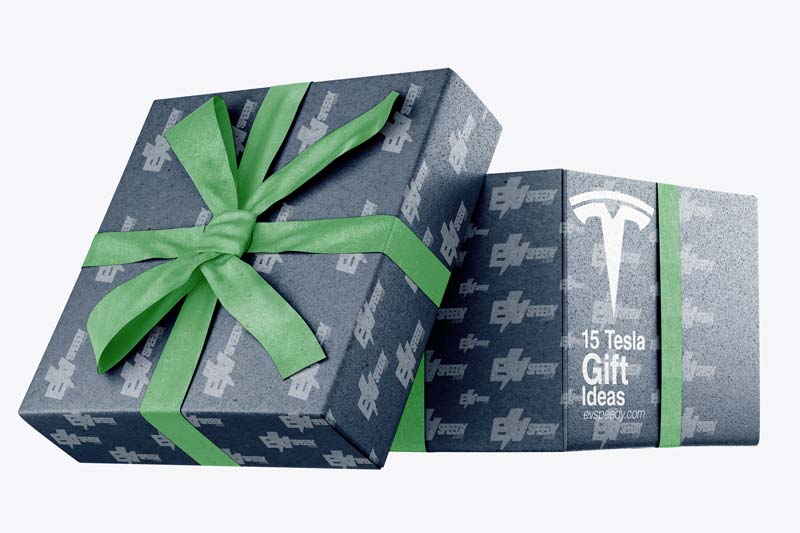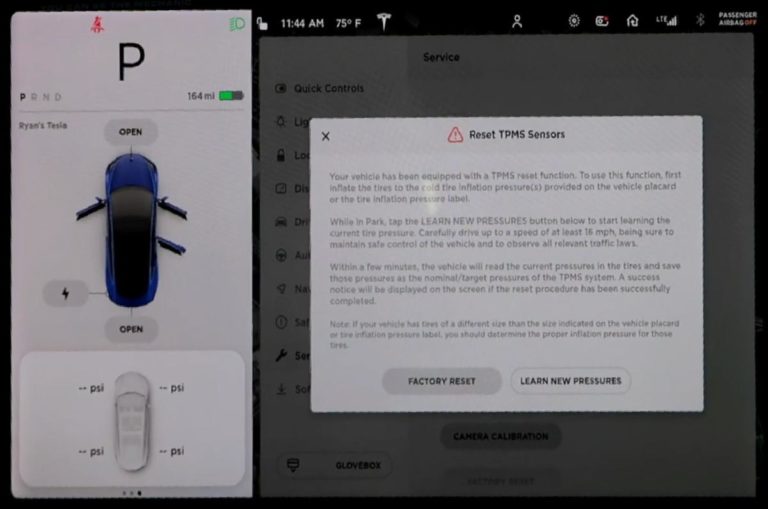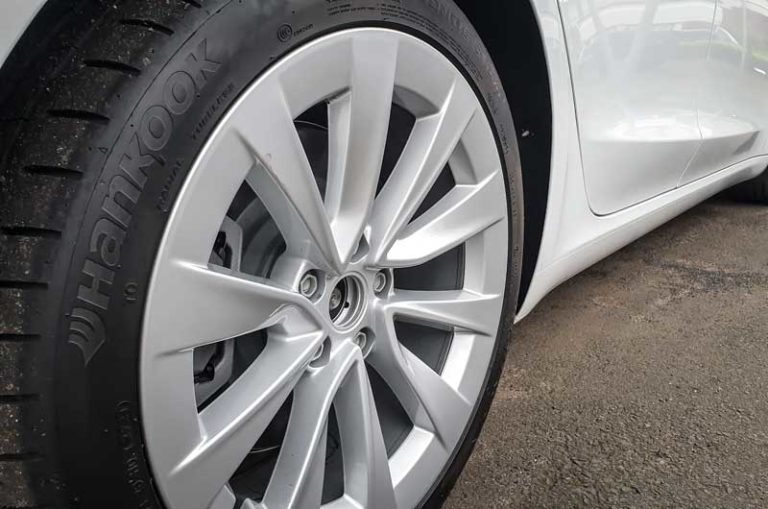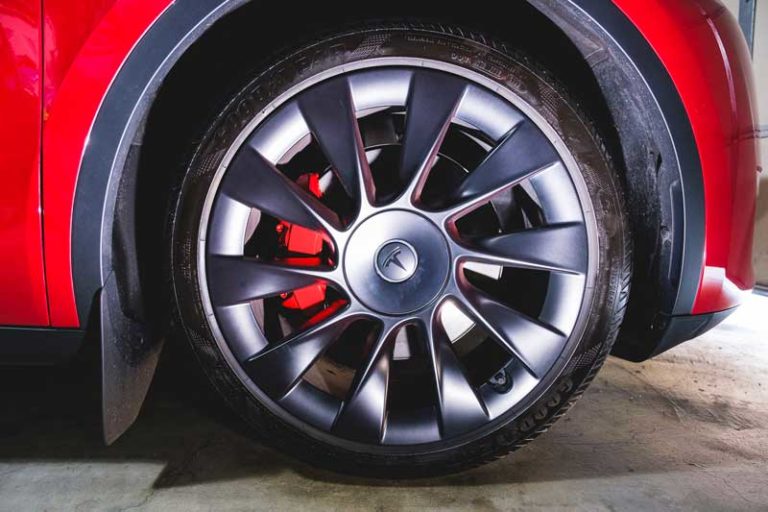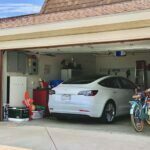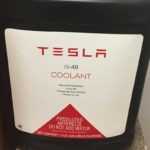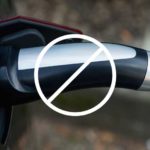The Tesla Model 3 comes standard with Aero Wheels, and for $1500 more, you can spring for the bigger Sport Wheels. Wheel choice used to boil down to aesthetics, but since wheels now have a more significant impact on performance, let’s see if spending the additional money is worth it.
Tesla Aero wheels are considered to be better. They are 18 in (46 cm) in diameter and have covers to aid aerodynamics. They are best if you want to save on costs while optimizing your driving range. However, if you value aesthetics, upgrading to the 19 in (48 cm) Sport wheels would be better.
This article will explain the differences between the Aero and Sport wheels by examining their specifications and each wheel set’s pros and cons. We will also cover the other wheel options Tesla offers.
- What’s the Difference Between Aero and Sport Wheels?
- What are Aero Wheels on Tesla?
- The Pros and Cons of Tesla’s Aero Wheels
- The Pros and Cons of Tesla’s Model 3 Sport Wheels
- A Performance Comparison Between the Aero and Sport Wheels
- Do Tesla Aero Wheels Make a Difference?
- Other Tesla Wheel Options
- Which Wheel Option Is for You?
What’s the Difference Between Aero and Sport Wheels?
There are a few differences between the two wheels, including diameter and aesthetics, among other things.
The main difference between the Aero and Sport wheels is size, with the Sport wheel having a diameter that’s an inch longer. The difference in size also affects the weight and how many times the wheels rotate for every mile.
Below is a table that shows and compares their specifications.
| Specification | Aero Wheels | Sport Wheels |
| Diameter | 18 inches (46 cm) | 19 inches (48 cm) |
| Width | 8.5 inches (21.6 cm) | 8.5 inches (21.6 cm) |
| Offset | +40mm (+1.6 in) | +40mm (+1.6 in) |
| Bolt Pattern | 5×114.3 | 5×114.3 |
| Center Bore | 64.1mm (2.5 in) | 64.1mm (2.5 in) |
| Weight | 23 lbs (10.4 kg) | 25 lbs (11.3 kg) |
| Rotations Per Mile | 790 (490 per km) | 787 (489 per km) |
| Tires | Michelin Primacy MXM4 235/45R18 98W XL | Continental Procontact RX 235/40R19 96W XL |
It’s important to note that slight differences in specifications can significantly impact performance. Aside from the numbers, the design also plays a vital role in determining how wheels perform.
Before we compare the performance and efficiency of both wheels, let’s first take a closer look at each set individually.
By the way, if you’d like to get the Best Tire Repair Kit for Every Tesla Model, then you can find it on this article that I wrote. It is somewhat related to this page and thought you might find it interesting.
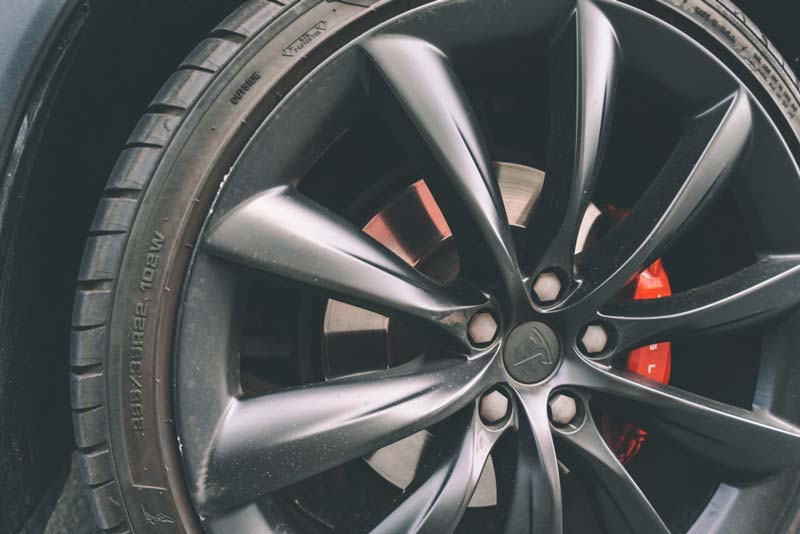
What are Aero Wheels on Tesla?
Aero wheels on Tesla vehicles are these cool-looking wheels that are designed to be super aerodynamic. They have a sleek and streamlined design with special hubcaps that cover the entire surface.
The main goal of these wheels is to reduce air resistance or drag as the car moves through the air. By making the car more aerodynamic, Tesla’s aero wheels help improve the overall efficiency and range of the vehicle, which is especially important for electric cars.
Tesla puts a lot of effort into making their aero wheels top-notch by using advanced technology like computational fluid dynamics analysis and wind tunnel testing to get the best performance.
It’s not just about looks; Tesla’s aero wheels are all about making the driving experience better and maximizing energy efficiency.
The Pros and Cons of Tesla’s Aero Wheels
The Aero wheels come standard with purchasing a Tesla Model 3 and feature a rather conventional ten-spoke design made from forged aluminum and concealed with detachable Aero Caps.
Unlike traditional wheels, which allow air to flow into the barrel to cause drag, the Aero Caps keep the air flowing past the wheels, reducing drag and increasing efficiency. The Aero Cap’s flat surface flush with the tires helps achieve better aerodynamics.
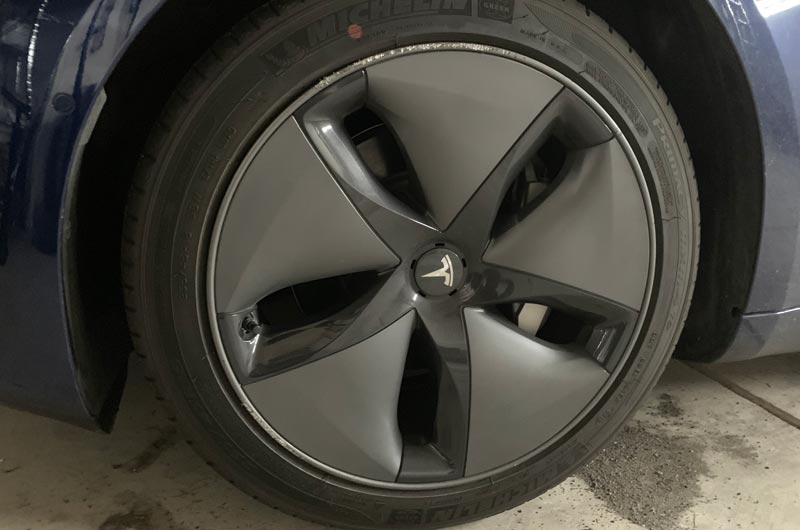
Another factor that makes the Aero wheels more efficient is their weight, or lack of it. Making the Aero Caps a separate piece instead of building a flat wheel from the ground up leads to substantial weight savings.
The Aero wheels are the lightest set available for any Tesla.
You can also remove the Aero Caps to expose the alloy wheels underneath. Tesla sells a center cap that covers the lug nuts as a separate accessory, should you want to use the wheels without the Aero Caps.
Pros of Tesla Aero Wheels
- Less weight. Lighter wheels translate to less effort needed from the motor to propel the car.
- Better efficiency. Having more efficient wheels means an increase in driving range and longer gaps between charge sessions.
- Higher load index. The tires that come with the Aero wheels have a load index of 98, which means they can support up to 1653 lbs (750 kg) when properly inflated.
- Less wear. Lighter wheels put less pressure on the tires, which leads to minor wear. The treadwear rating on the Michelin Tires is 500.
Cons of Tesla Aero Wheels
- Proneness to curb rash. Since the Aero Caps are flush with the tires’ sidewall, there’s a greater tendency to scrape them against a curb.
- Less pleasing aesthetics. Looks are subjective, but many people agree that bigger wheels generally look better. Having the Aero Caps on makes the wheels look like much cheaper hubcaps.
You can use this online Tesla tire calculator to find how long any Tesla Model tire will last. You can also estimate the number of miles left on your current set and how many days you have until they need to be swapped out for new ones. If that is the case, you can also find the price for any set of Tesla tires by selecting the appropriate tires. Have fun!
The Pros and Cons of Tesla’s Model 3 Sport Wheels
The Tesla Sport Wheels, also known as the Stilettos, are available as an optional upgrade for the Tesla Model 3. As stated earlier, the most significant difference between the Sport and Aero wheels is size, apart from the fact that the Sport wheels do not come with Aero covers.
Tesla’s sport wheels are also made from forged aluminum and feature a 10-spoke design. The silver finish contrasts the wheels with the tires, making their design pop.
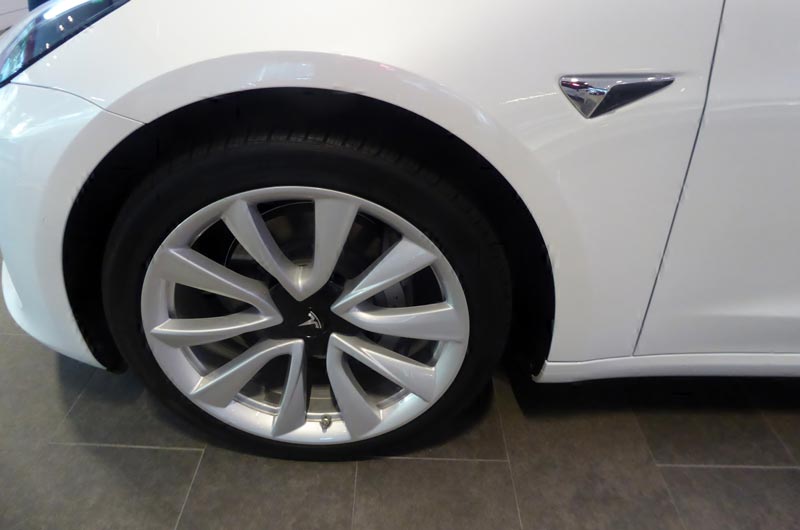
Putting bigger wheels on the same car means using tires with a thinner side profile. In the case of this comparison, the Aero wheels’ side walls are over 10 mm (0.4 in) taller than those on the Sport wheels.
Pros of Tesla Model 3 Sport Wheels
- More pleasing aesthetics. Bigger wheels cover more of the wheel well, significantly enhancing the car’s look. The Sport rim is also less likely to scratch.
- More grip and better braking. Thinner side walls and a larger wheel diameter improve the overall stiffness, which contributes to better performance, particularly when it comes to cornering and braking.
Cons of Tesla Model 3 Sport Wheels
- Stiffer ride and more road noise. Stiffer wheels translate to a harsher ride since there is less rubber between the wheel and the ground to absorb impact. The stiffer compound and wheel combination also lead to more road noise.
- Faster tire wear. The heavier weight of the bigger wheels and the increase in performance may also cause the tires to wear out faster. The treadwear rating is 400 on the Continental tires that come with the Sport wheels.
- Added cost. Aside from the cost of the wheels, tires for bigger wheels are more expensive. And since low-profile tires tend to wear out faster, maintaining bigger wheels will cost more.
- Less efficiency. The added weight and less aerodynamic design take a toll on efficiency and decrease EVs’ driving range.
- Lower load index. The tires that come with the Sport wheels have a load index of 96, which means they can support up to 1565 lbs (710 kg) when properly inflated. This is 88 lbs (40 kg) lower than the load index of the Aero wheels.
A Performance Comparison Between the Aero and Sport Wheels
Now that we’re more familiar with the Aero and Sport wheels, it’s time to reveal how they stack up against each other when it comes to performance. The difference in performance between the two wheels and which one did better under each criterion is quite surprising.
Acceleration From 0-60 mph (0-96 km/h): Aero Wheels Vs Sport Wheels
Scientifically speaking, increasing your wheel’s diameter increases the amount of force needed to make them move. In essence, a car’s engine, or electric motor, will require more effort to spin a bigger wheel, which will lead to poorer acceleration.
However, there’s proof that a Tesla Model 3 with 19-inch (48-centimeter) Sport wheels and Continental Tires can outperform the same car with the 18-inch (46-centimeter) Aero wheels with Michelin Tires.
This could be attributed to the Continental on the Sport wheels being more performance-oriented, while the Michelin’s on the Aero wheels prioritize efficiency.
Skidpad Performance (200 ft or 61 m Diameter): Tesla Aero Wheels vs Sports
A skidpad test involves driving a car around a fixed radius and slowly accelerating until the outer tires slip out of the radius. The lateral G-force is measured to see how much force was achieved before the car lost grip.
In the skidpad test, the Tesla Model 3 also did better with the Sport wheels with Continental tires fitted. This was also somewhat surprising since both tires have the same width and should have the same contact patch with the ground.
It’s highly possible that the Sport wheels performed better in this test due to the low-profile tires and bigger wheel diameter, which increased overall stiffness.
Apart from the grip, the Sport wheels offered more directional stability and sharper steering response.
Braking From 60-0 mph (96-0 km/h): Tesla Wheels Comparison
In a brake test from 60 to 0 mph (96-0 km/h), the Sport wheels outperformed the Aero wheels by a significant margin. The difference in stopping distance between the wheels was an astonishing 5 feet (1.5 meters). Although the brake system is the same for the two wheels, the size of the wheel can impact the stopping distance.
Efficiency and Driving Range: Tesla Sport Wheels vs Aero
Given its lightweight and aerodynamic design, it’s no surprise that the Aero wheels are the winner in this category. The lightweight helps optimize efficiency at low speed, while the Aero covers improve efficiency at higher speeds.
A Tesla Model 3’s driving range can simply increase between 3 to 4.7% by putting the Aero Covers on. The driving range can improve by up to 6% when switching from the Sport to the Aero wheel package.
The YouTube video below from Edmunds Cars shows some of the actual performance tests done to compare the Aero and Sport as he reviews Model 3 wheels:
The table below shows the actual performance figures based on comparison tests and data gathered on the performance of Aero and Sport Wheels.
| Aero Wheel Package | Sport Wheel Package | ||
| Acceleration (0-60 mph or 0-96 km/h) | 5.3 seconds | 5.1 seconds | |
| Braking (60-0 mph or 96-0 km/h) | 133 ft (40.5 m) | 128 ft (39 m) | |
| Skid Pad (200 ft or 61 m) | 0.85 g (0.03 oz) | 0.93 g (0.03 oz) | |
| Driving Range | 322 miles (518 km) | 304 miles (489 km) |
Performance Figures for Aero vs Sport Wheel
Do Tesla Aero Wheels Make a Difference?
You betcha! Tesla’s aero wheels definitely make a difference when it comes to how well the car performs and how far it can go on a single charge.
These wheels are designed to reduce drag, and that means less resistance from the air as you zip down the road. With less drag, your Tesla can move more efficiently and use less energy to maintain its speed.
The result? You get a longer driving range, which is great news for electric vehicle owners. Many Tesla drivers have reported seeing a noticeable increase in range after switching to aero wheels, especially when cruising on the highway.
But it’s not just about the range. Aero wheels also give you a smoother ride, better handling, and even a quieter experience because they help minimize the noise caused by air turbulence. So, if you’re all about getting the most out of your Tesla, the aero wheels are definitely worth considering.
Other Tesla Wheel Options
There are many other wheel options available for the different Tesla models, with sizes ranging from 18 inches (46 cm) to as high as 22 inches (56 cm).
Now that we’ve covered how wheels and tires can impact performance, it should be easier to choose a package that suits your needs.
Below are tables that show the different wheel and tire packages for each Tesla model.
Tesla Model S Wheels
| Name | Slipstream | Cyclone | Turbine | Arachnid |
| Diameter | 19 inches (48 cm) | 19 inches (48 cm) | 21 inches (53 cm) | 21 inches (53 cm) |
| Width | 8 inches (20 cm) | 8 inches (20 cm) | 8 inches (20 cm) front 9 inches (23 cm) rear | 8 inches (20 cm) front 9 inches (23 cm) rear |
| Offset | +40mm (+1.6 in) | +40mm (+1.6 in) | +40mm (+1.6 in) | +40mm (+1.6 in) |
| Cost To Upgrade | – | $2500 | $4500 | $2500 |
| Cost To Buy | – | $4400 | $6000 | $4400 |
| Tire Size | 245/45R19 | 245/45R19 | 245/35ZR21 | 245/35ZR21 -Front 265/35ZR21- Rear |
Tesla Model 3 Wheels
| Name | Aero | 19” Stiletto (Sport) | 20” Stiletto |
| Diameter | 18 inches (46 cm) | 19 inches (48 cm) | 20 inches (51 cm) |
| Width | 8.5 inches (21.6 cm) | 8.5 inches (21.6 cm) | 8.5 inches (21.6 cm) |
| Offset | +40mm (+1.6 in) | +40mm (+1.6 in) | +40mm (+1.6 in) |
| Cost to upgrade | – | $1500 | – |
| Cost to buy | – | $3000 | $4000 |
| Tire Size | 235/45R18 | 235/40R19 | 235/35ZR20 |
Tesla Model X Wheels
| Name | Slipstream | Turbine |
| Diameter | 20 inches (51 cm) | 22 inches (56 cm) |
| Width | 9-10 inches (23-25 cm) | 9 inches (23 cm) front 10 inches (25 cm) rear |
| Offset | +35mm (1.4 in) | +35mm (1.4 in) |
| Cost to upgrade | $2000 (sonic carbon gray version) | Only available for Tesla Model X Performance |
| Cost to buy | $5000 (sonic carbon gray version) | |
| Tire Size | 265/45R20 | 265/35R22 front 285/35R22 rear |
Which Wheel Option Is for You?
Many people still pick their wheels based on style and, of course, their corresponding budget. But if you want to consider performance, the rule of thumb is that efficiency, acceleration, load capacity, and comfort may all take a hit as you increase your wheel size.
The wheel option for you will be whichever wheel corresponds to your needs. If you consider aesthetics over efficiency, larger wheels shouldn’t be a problem for you. However, if you are looking for a low-maintenance option, the smaller wheels will be better for you.
So if you value aesthetics, braking, and cornering enough, and you don’t mind the additional onset and maintenance costs, then getting bigger wheels shouldn’t be an issue for you. Remember, you’ll have to get a bigger tire package as well.
On the flip side, if comfort, efficiency, and lower maintenance costs sound more appealing, the choice is clear; go for the smaller wheels for your electric transport.
Check out these 20 great gift ideas for yourself or a Tesla fanboy.
Contact Us if you have any questions or queries.

